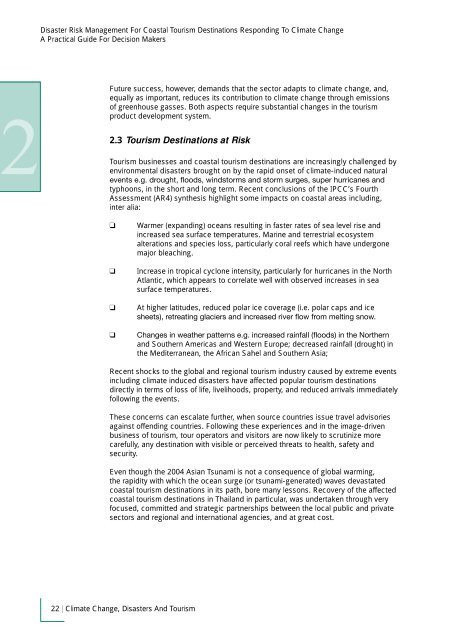Disaster Risk Management For Coastal Tourism Destinations - DTIE
Disaster Risk Management For Coastal Tourism Destinations - DTIE
Disaster Risk Management For Coastal Tourism Destinations - DTIE
You also want an ePaper? Increase the reach of your titles
YUMPU automatically turns print PDFs into web optimized ePapers that Google loves.
<strong>Disaster</strong> <strong>Risk</strong> <strong>Management</strong> <strong>For</strong> <strong>Coastal</strong> <strong>Tourism</strong> <strong>Destinations</strong> Responding To Climate Change<br />
A Practical Guide <strong>For</strong> Decision Makers<br />
Future success, however, demands that the sector adapts to climate change, and,<br />
equally as important, reduces its contribution to climate change through emissions<br />
of greenhouse gasses. Both aspects require substantial changes in the tourism<br />
product development system.<br />
2.3<br />
<strong>Tourism</strong> <strong>Destinations</strong> at <strong>Risk</strong><br />
<strong>Tourism</strong> businesses and coastal tourism destinations are increasingly challenged by<br />
environmental disasters brought on by the rapid onset of climate-induced natural<br />
<br />
typhoons, in the short and long term. Recent conclusions of the IPCC’s Fourth<br />
Assessment (AR4) synthesis highlight some impacts on coastal areas including,<br />
inter alia:<br />
<br />
<br />
<br />
<br />
Warmer (expanding) oceans resulting in faster rates of sea level rise and<br />
increased sea surface temperatures. Marine and terrestrial ecosystem<br />
alterations and species loss, particularly coral reefs which have undergone<br />
major bleaching.<br />
Increase in tropical cyclone intensity, particularly for hurricanes in the North<br />
Atlantic, which appears to correlate well with observed increases in sea<br />
surface temperatures.<br />
At higher latitudes, reduced polar ice coverage (i.e. polar caps and ice<br />
<br />
<br />
and Southern Americas and Western Europe; decreased rainfall (drought) in<br />
the Mediterranean, the African Sahel and Southern Asia;<br />
Recent shocks to the global and regional tourism industry caused by extreme events<br />
including climate induced disasters have affected popular tourism destinations<br />
directly in terms of loss of life, livelihoods, property, and reduced arrivals immediately<br />
following the events.<br />
These concerns can escalate further, when source countries issue travel advisories<br />
against offending countries. Following these experiences and in the image-driven<br />
business of tourism, tour operators and visitors are now likely to scrutinize more<br />
carefully, any destination with visible or perceived threats to health, safety and<br />
security.<br />
Even though the 2004 Asian Tsunami is not a consequence of global warming,<br />
the rapidity with which the ocean surge (or tsunami-generated) waves devastated<br />
coastal tourism destinations in its path, bore many lessons. Recovery of the affected<br />
coastal tourism destinations in Thailand in particular, was undertaken through very<br />
focused, committed and strategic partnerships between the local public and private<br />
sectors and regional and international agencies, and at great cost.<br />
22 | Climate Change, <strong>Disaster</strong>s And <strong>Tourism</strong>

















